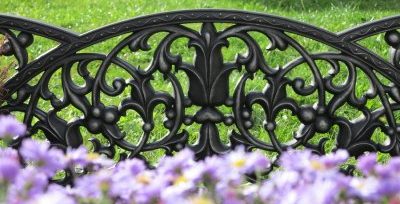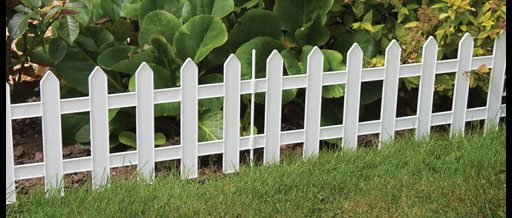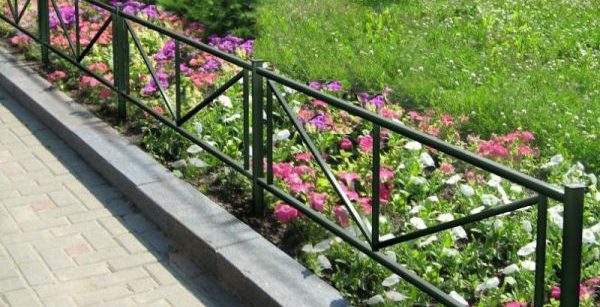Original fences for flower beds made of metal with your own hands
Content
Pros of metal fences
Metal fences for flower beds are forged, cast or welded, their main function is decorative, although they will perfectly protect flower beds from a child's ball, bicycle or lawn mower. In combination with other elements of the personal plot - lamps, benches, barbecues, they are designed to become an ornament without losing their utilitarian meaning. The cast-iron lace of the fence around the flower bed will look impressive, even if this is the only metal design detail, but such accents should fit into the overall landscape picture.
Today, fences with floral patterns are popular. As a rule, they do not exist in the open sale, but there are many specialized firms that make such decorative fences for flower beds to order. Most often, they offer clients their own designs, but you can come to them with your own ideas. Usually, such fences are made in separate sections, so it is easier to transport them and then install them on site.
These fences are strong, practical and durable. Usually cast or forged sections are made from steel or cast iron, welded sections can be made from any metal profile. Being outdoors all year round, they are constantly exposed to all the elements, but, nevertheless, they remain the most durable possible options. Since they consist of separate parts, they are assembled on site, then, if necessary, they can be easily dismantled and moved to another place.
Metal is an expensive material, but since decorative fences are usually low (most often 30 - 50 cm), the final cost of the product suits many, and you can install them yourself.
Iron combines beautifully with other natural materials, designers love to use it together with natural stone or brick. Metal fences, especially with forging elements, give a unique charm to flower beds. They emphasize the luxury of the rose garden, even in winter, against the backdrop of snow-covered flower beds, add amazing beauty to the entire site.
Video "Instructions for assembling the fence"
Detailed video instructions for assembling the fence. This instruction can be applied to any type of fence.
Minuses
There are very few disadvantages of a decorative metal fence. Usually they talk about high cost. Making even a small flower bed, if you measure its perimeter, can be expensive. With a long product length, a small height and a huge service life can become the pros.
The second drawback is called corrosion. Indeed, a fence that perfectly resists any mechanical stress can corny corny with a lack of care. Some manufacturers recommend dyeing their products annually. But the chemical industry does not stand still, you can treat the fence with a special anti-corrosion compound, and then over time, just update the treatment or painting.The real owner always monitors what is in the house and on the site, caring for an iron decorative fence does not take much time compared to other worries.
The large weight and complexity of the installation can also be attributed to disadvantages. And yet - they can become a traumatic factor. If you slip, catch and fall on the sharp iron stakes, you can get very seriously injured. That is why twisted lace should not end with sharp corners or stakes. But this issue is being successfully solved by designers.
Mounting
Metal fences around flower beds can be very different, it all depends on the choice of the owner. Someone can take old pipes, cut them, dig them around the perimeter of the flower garden - you get a very original design. Especially if you fill them with earth, plant flowers. Succulents look interesting in such dishes, and ampelous or climbing plants will create a romantic joyful atmosphere.
Anyone who has a thick wire lying around can bend it in a semicircle, stick it into the ground and get a low, pretty border. If you have a welding machine and the appropriate skills, you can weld a decorative fence of varying degrees of complexity from a round or square profile with a cross section of 10 to 16 mm, and then install it on the site. Installation can be of two types:
- the sections are simply stuck into the ground, they are held on special pins;
- the fragments are installed on the foundation.
The first case assumes the temporary nature of such a design, the fence can be easily rearranged to another place, but it will not protect the flower garden from the spread of weeds. In addition, it will easily lose stability under the influence of water and the weight of the plants, bend over or even fall, which will not add beauty to the site. The fence, installed on the foundation, looks solid, which means it is reliable. It remains in the position that was given to it, performs decorative and purely utilitarian functions - it looks beautiful, undoubtedly fits into the design of the site, at the same time, it protects the flower bed from the penetration of weeds and the encroachments of children, pets, lawn mowers, bicycles.
Iron lace looks good on stone or brick. Fences around the site are often made on a stone (brick) base or separated by support posts made of these materials. They do the same with their little decorative cousins. You can order sections of the fence from the manufacturer, and then install it yourself on the site. This will most likely require welding, well, and materials for the foundation - cement, sand, bricks (or stone).
First of all, you need to decide what the fence sections will be installed on. You can make a strip foundation, or you can deepen brickwork or stone into the ground. In addition, if support posts are intended, they must also be made at the same time as the foundation. I must say that all these issues must be resolved before the production of iron fragments - during the creation of a design project.
If the fence is to be installed on a concrete foundation that protrudes 10 cm above the ground, then it must be done in advance, since the concrete must still harden. Around the perimeter of the flower garden, you need to dig a trench, 20 cm deep, 10 cm wide, align the walls and the bottom, then fill up the sand, water it with water so that it settles down more densely. If the foundation does not protrude above the ground, and the soil is dense enough, then you can do without formwork and pour the solution directly into the trench. For a protruding foundation (or if the soil is light, sandy), formwork must be made.
For this, wooden walls are installed on the sides of the trench; it is better to fix them with spacers. The trench is poured with a solution to the desired height, which was previously marked with a stretched fishing line, and left to freeze. The solution can be bought ready-made or prepared by yourself at the rate: 1 part of cement - 2 parts of sand.After the cement hardens, the formwork is removed, the ground is leveled. Knowing in advance at what distance from each other the support pipes (pins) will be installed, to which the fragments of the fence are welded, they are installed simultaneously with the foundation pouring.
This is a description of the basics of editing, then there are variations. There may be brick or masonry around the support pipes, they may not be at all, and each fragment of the fence will have pins that will be installed in the cement. Another, even more simple design is possible, when the foundation is made only for the support pipes.
Video "A few examples of metal fences"
Demonstration video with several examples of metal fences. Such fences can be used for flower beds.






